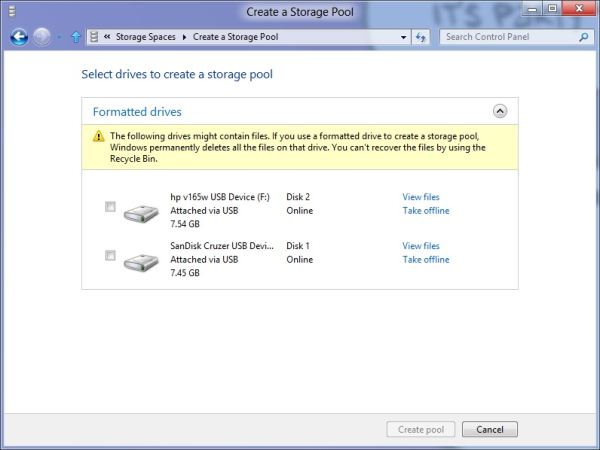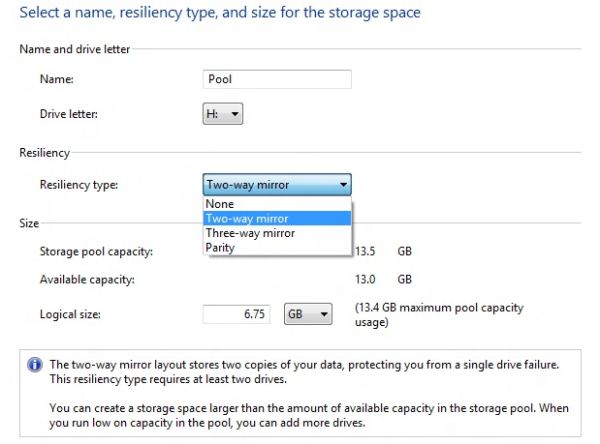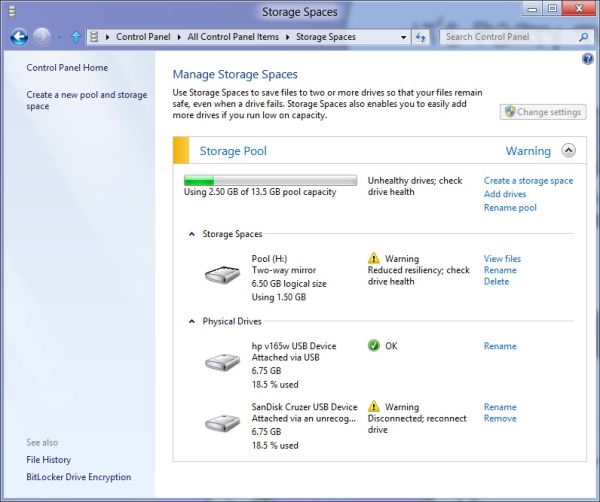In-Depth with the Windows 8 Consumer Preview
by Andrew Cunningham, Ryan Smith, Kristian Vättö & Jarred Walton on March 9, 2012 10:30 AM EST- Posted in
- Microsoft
- Operating Systems
- Windows
- Windows 8
Refresh and Reset
One of Windows 8’s most appealing new features for enterprises is something Microsoft calls “refresh and reset.” It adds the ability to automatically roll a busted Windows install back to a pristine state. The “refresh” functionality rolls back changes to system files and installed desktop applications (unless you create your own recovery image; more on that in a minute) but preserves user data, and the “reset” functionality reverts Windows to its freshly-installed state. This is analogous to the appliance-like “reset” or “restore factory defaults” functions present in many smartphones, tablets, MP3 players, and other electronics capable of storing customized settings and user data.
Refresh and reset, accessible from the “General” section of the Metro settings and from the WinRE recovery menu, both use the same image-based technology used by Windows Setup to do their thing. Since Vista, Windows install media has included (1) a collection of files required to enabled booting from the media and (2) a large, monolithic .WIM image file that is uncompressed and copied to the hard drive during install—this contrasts with the setup process for Windows XP and earlier versions, which expanded and copied individual files from the install media to the hard drive. Microsoft also offers a number of tools (many included in the Windows ADK) to let end users and IT admins create their own, customized .WIM images, which can be used to deploy a custom Windows installation to many computers quickly.
So, to continue the Windows Setup analogy, “refreshing” the PC acts as an upgrade install, replacing the operating system while preserving user data. Metro-style apps will also be preserved, but installed desktop apps will be removed and a list of them will be placed on your desktop in HTML format for reference—Microsoft’s reasoning for this behavior is that malicious desktop apps are more likely to be the cause of serious problems than are Metro apps from the Windows Store’s “walled garden”.
“Resetting” the PC acts as a clean install that blows away all user data, especially useful if a PC is being repurposed or sold or otherwise transferred from one party to another. The reset option also gives you the option of erasing the hard drive securely so that sensitive data won’t be at risk.
Recimg: Creating Custom Recovery Images
There’s one more major component to the refresh feature, and it’s probably the most interesting one—using the Recimg command-line tool, users can create snapshots of their systems to use as the reference point for a refresh. These snapshots, which are really just the same .WIM images used by Windows Setup, will store settings, drivers, and both Metro and desktop applications, and can be created at any time and stored basically anywhere, including the Windows partition.
These recovery images can even be used to replace factory restore partitions—suppose that you buy a cheap Windows 8 PC, as many people will do, and it comes with the requisite sea of crapware and no recovery DVDs or USB sticks. Thanks to Recimg, you can uninstall that crapware, update drivers, install programs you actually want, capture an updated crapware-free image, and then delete the old recovery image/partition from your hard drive to save the space. Relatives who have broken their PCs can then use the recovery image to revert their PCs to an unbroken state without losing their personal data.
Sounds useful, right? Let’s talk a bit more about how to use recimg.
First, you’ll need to run the Command Prompt as an administrator—otherwise, Recimg won’t run. From here, you can launch recimg with one of five different switches:
- Recimg /createimage <directory> will create a new install.WIM image containing your installed drivers and programs to a directory you specify. The easiest way to do this is to store it on a local hard drive, but an external drive will also work as long as the external drive is plugged in when you initiate the refresh). The size of the .WIM file will vary based on what you’ve got installed, but images usually start at 3 or 4 GB and work their way up from there.
- Recimg /setcurrent <directory> will set the install.WIM image in the specified directory as the one Windows will use when refreshing your PC. If you run Recimg /createimage but don’t use /setcurrent afterward, Windows won’t know to use your image.
- Recimg /deregister will deregister the currently set recovery image. If a previously-created recovery image exists, Windows will revert to using it. If no image exists, Windows will ask for you to insert install media when you try to refresh the PC.
- Recimg /showcurrent tells you where your current recovery image is stored.
- Recimg /? tells you all of the stuff I just told you.
The primary downside of Recimg is that it can’t be used to reset a PC, only to refresh. My test PCs always asked me to insert Windows install media to use the reset functionality—OEM PCs that ship with Windows 8 may behave differently, but we’ll have to wait and see.
That aside, Recimg and the refresh/reset functionality do a solid job of making OS reinstallation a bit simpler—Windows Setup isn’t very hard now but it, combined with the challenge of reinstalling apps and drivers, has made reinstalling a fresh copy of Windows more of a pain than it needs to be.
Storage Spaces
Windows 8's new Storage Spaces functionality allows users to pool different physical drives together into one large logical drive, not unlike the now-discontinued Windows Home Server Drive Extender. You can pool drives connected by just about any common interface, including USB, SATA, and SAS.
Once you've created a storage pool using two or more drives, you can then set up one or more "spaces" that will be seen by the operating system as a logical drive which can be formatted, partitioned, and used just as a physical disk would be. To provide redundancy, you can either apply the "mirrored" attribute to your pool, which makes sure that a copy of every file in the pool is stored on at least two different physical drives, or the "parity" attribute, which uses some drive space to store redundancy information—in the event of drive failure, this information is used to rebuild your pool and enforce mirroring. Microsoft notes that while the two redundancy options are similar, the "parity" attribute is best used for large sequential files or less-frequently-accessed content, since it has a higher random I/O overhead. As with any redundancy technology, you'll give up maximum drive capacity in exchange for data integrity, so weigh your priorities carefully when you create your pool.
When creating a new Storage Space, you can specify a maximum size larger than the amount of available physical space—the system will prompt you when the storage pool needs more drives to work with. Microsoft calls this "thin provisioning," which means that drive capacity is only reserved as you store data to the drive rather than all at once. You can also expand the maximum size of the Storage Space at a later point if necessary. Creation of these spaces can be scripted using PowerShell.
My experience with Storage Spaces was a bit spotty—it didn't seem to want to recognize some of the USB sticks I plugged into my computer, and it wasn't clear why. It may be that there are some unspoken speed or hardware requirements that a couple of my drives just weren't meeting. Once I did get it working, though, it worked as designed—as you can see in the screenshot above, I unplugged one of the drives from the pool I had configured to simulate what would happen in the event of drive failure, and the redundancy features ensured that I was still able to access all files I had copied to the pool. One could then reconnect the drive or add a new one to the pool to restore redundancy.













286 Comments
View All Comments
Andrew.a.cunningham - Friday, March 9, 2012 - link
Hopefully some of those multi-monitor and "four corners"-related issues get worked out in the release candidate. It would help a lot.Impulses - Saturday, March 10, 2012 - link
I'm not holding my breath for that... It took them until Windows 8 to add basic taskbars for the extra screens, it'll probably fall to 3rd party developers to make the whole Metro/Desktop paradigm usable with multiple displays, just like we relied on them for multiple taskbars, better wallpaper support, etc.Exodite - Saturday, March 10, 2012 - link
Well, I don't know if my 2c is worth much but the answer to that would - in my opinion - be 'why should we?'.I don't /have/ to use Windows, it's a personal choice.
If the UI, or anything about the user experience in general really, ends up being a bother for me I can quite easily migrate to another platform.
I suppose this is a good thing, if taking the long view. Microsoft might inadvertently encourage diversification of the desktop computer space by making W8 horrible to use for a notable minority.
B3an - Friday, March 9, 2012 - link
@Andrew and everyone else who worked on this - great article :)It's nice to FINALLY see a very detailed article that shows all the improvements in Windows 8. Too many people are focused on just Metro. I'm sick of having to write long posts explaining to people how to use Win 8, and why it's faster and more powerful for most tasks if people would actually just learn new things, and then having to mention all the new features to the desktop. Now i can just refer people to this article ;)
Great work.
jabber - Friday, March 9, 2012 - link
Don't have time to learn new stuff that's not putting money in the bosses wallet, just need to get the work I'm paid to do done ASAP. That's why Windows 7 worked so well.Companies don't pay folks to sit and learn learn new software or want to hear them bleating on about how they don't know what to do.
Too much like hard work. Sorry but that's how it is. Business as usual is king.
I too can see some great improvements in 8 its just that it (as in Metro) is NOT designed for a standard run of the mill PC environment.
Windows tablets are not going anywhere. That ship sailed for MS years ago. It's the Zune all over again in that regard. So just keep it for phones and maybe adding a little fun to those desktop all in one monstrosities that HP etc. make.
B3an - Saturday, March 10, 2012 - link
I'm so glad MS have not listened to people like you with Win 8. If they did then im sure we'd all still be using Windows 3.1.And your comment makes no sense. Win 8 is faster for work when you actually get used to it, so in the long run this will pay off as people will be more productive. And people have to learn new software all the time, like the Ribbon in MS Office.
Magnus101 - Friday, March 9, 2012 - link
I am on a multi-monitor setup and I tried the dev version in Virtual Box last month.I had to turn off Windows 8(had to do a different setting for the virtual machine, I think).
Couldn't find where to power off.
Found out by a video that I had to hoover in the right hand corner, but that didn't work. I thought the version I used had dumped that ability (the youtube video was quite old).
So I had to look up a shortcut to open up the start menu and finally get it to shut down.
Of couse the problem was that I used multiple monitors (use 3) and that I coudln't "snap" to the point where the start menu was.
This shows how extremely bad this is.
Another idiotic thing with metro is that programs behaves like apps on a mobile phone. They don't really shut down unless you force them to.
I tried one of the metro games where there was some music playing. There was no option to quit the game, so when I left it, the music was STILL playing in the background.
I had to force close the damn thing to stop the music playing!
And I find absolutely nothing that makes my experience better with metro than the Windows 7 taskbar. Less clicks and more things in a smaller place is ideal for me. Not to mention that the horizontal scrolling is idiotic in metro.
Look at how Unity in Ubuntu was received when it was released. People fled to Linux Mint, where there are options to use the "old style" desktop.
One thing that was really good with Windows 8, though, was the new Explorer with many enhancements and actually more space (the bottom part is free compared to win 7).
I just wish there would be a "Windows 8 desktop" version where the users like me who don't have a windows tablet, Xbox 360 or a windows phone could enjoy the other enhancements not letting metro totally destroy the experience!
I guess 80-90% will still use older windows version even at the end of 2013 if nothing is done about this crap. Things like metro or unity just doesn't work on a normal Pc and aren't well received by users!
faizoff - Friday, March 9, 2012 - link
You might want to try out the Consumer preview since you've tried the metro apps on the Dev preview. They mention in the article about closing out the apps. They aren't that difficult to close now. Though shutting down and restarting the computer is still a chore.PopinFRESH007 - Sunday, April 15, 2012 - link
Hovering the mouse over the left most 80 pixels to pop out the multi-tasking tray and then click-holding the app and dragging it down is a whole lot more work than clicking a little red x.faizoff - Friday, March 9, 2012 - link
I'll have to read this thoroughly when I get home. I find myself really liking Metro even on a PC. I don't see myself getting it when it comes out for the PC though. Only way I'm getting it is when Win 8 tablets come out.Skimming through the comments, I had mentioned about the restart and shutting down annoyance. I found a shortcut that allows to place a tile on the metro screen thereby clicking only once to shutdown or restart the computer.